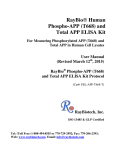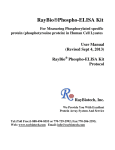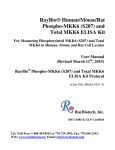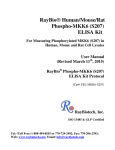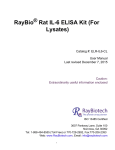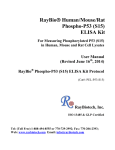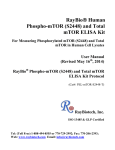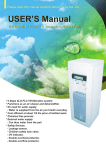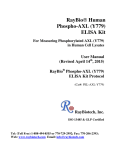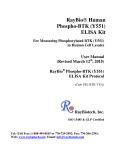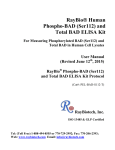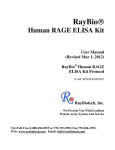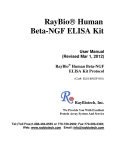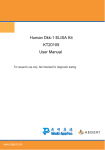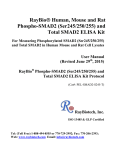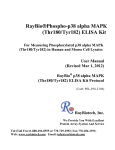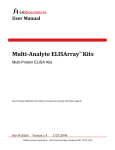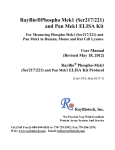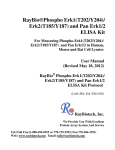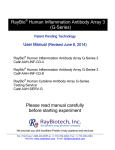Download User Manual - RayBiotech, Inc.
Transcript
RayBio Human Phospho-CREB (S133) and Total CREB ELISA Kit For Measuring Phosphorylated CREB (S133) and Total CREB in Human Cell Lysates User Manual (Revised April 24th, 2015) RayBio Phospho-CREB (S133) and Total CREB ELISA Kit Protocol (Cat#: PEL-CREB-S133-T) RayBiotech, Inc. ISO 13485 & GLP Certified Tel: (Toll Free) 1-888-494-8555 or 770-729-2992; Fax: 770-2062393; Web: www.raybiotech.com Email: [email protected] RayBiotech, Inc. RayBio® Phospho-CREB (S133) and Total CREB ELISA Kit Protocol TABLE OF CONTENTS I. Introduction……..………………………………2 II. Material Provided…………..………..………….3 III. Storage.…………………………………….……3 IV. Additional Materials Required………………….4 V. Sample Preparation……………………………...4 VI. Reagent Preparation……………………………..5 VII. Assay Procedure………………………………....7 VIII. Assay Procedure Summary……………………...8 IX. Typical Data……………………………………..9 X. i. Positive Control…………………………….9 ii. PMA Stimulation of HeLa Cell Lines…….10 Troubleshooting Guide.………………...….…..11 1 RayBio Phospho-CREB (S133) and Total CREB ELISA Kit Protocol I. INTRODUCTION RayBio® Phospho-CREB (S133) and Total CREB ELISA kit is a very rapid, convenient and sensitive assay kit that can monitor the activation or function of important biological pathways in human cell lysates. By determining phosphorylated CREB protein in your experimental model system, you can verify pathway activation in your cell lysates. You can simultaneously measure numerous different cell lysates without spending excess time and effort in performing a Western Blotting analysis. This Sandwich ELISA kit is an in vitro enzyme-linked immunosorbent assay for the measurement of human phospho-CREB and total CREB. An anti-pan CREB antibody has been coated onto a 96-well plate. Samples are pipetted into the wells and CREB present in a sample is bound to the wells by the immobilized antibody. The wells are washed and rabbit anti-CREB (S133) antibody is used to detect phosphorylated CREB or mouse anti-CREB antibody is used to detect pan CREB. After washing away unbound antibody, HRP-conjugated anti-rabbit IgG or anti-mouse IgG is pipetted to the wells. The wells are again washed, a TMB substrate solution is added to the wells and color develops in proportion to the amount of CREB (S133) or pan CREB bound. The Stop Solution changes the color from blue to yellow, and the intensity of the color is measured at 450 nm. 2 RayBio Phospho-CREB (S133) and Total CREB ELISA Kit Protocol II. MATERIAL PROVIDED 1. CREB Microplate (Item A): 96 wells (12 strips x 8 wells) coated with anti-pan CREB antibody. 2. Wash Buffer Concentrate (20x) (Item B): 25 ml of 20x concentrated solution. 3. Assay Diluent (Item E2): 15 ml of 5x concentrated buffer. For diluting cell lysate sample, detection antibody (Item C) and HRPconjugated IgG Concentrate (Item D). 4. Detection Antibody CREB (S133) (Item C-1): 1 vial of rabbit antiCREB (S133) (1 vial is enough to assay half microplate). 5. Detection Antibody CREB (Item C-2): 1 vial of mouse anti-CREB (1 vial is enough to assay half microplate). 6. HRP-conjugated Anti-rabbit IgG (Item D-1), 25 µl of 1000x concentrated HRP-conjugated anti-rabbit IgG. 7. HRP-conjugated Anti-mouse IgG (Item D-2), 12 µl of 1000x concentrated HRP-conjugated anti-mouse IgG. 8. TMB One-Step Substrate Reagent (Item H): 12 ml of 3,3’,5,5’tetramethylbenzidine (TMB) in buffered solution. 9. Stop Solution (Item I): 8 ml of 0.2 M sulfuric acid. 10. Cell Lysate Buffer (Item J): 5 ml 2x cell lysis buffer (not including protease and phosphatase inhibitors). 11. Positive Control HELAS001-1 (Item K): 1 vial of lyophilized powder from HeLa cell lysate. III. STORAGE Upon receipt, the kit should be stored at –20°C. Please use within 6 months from the date of shipment. After initial use, Wash Buffer Concentrate (Item B), Assay Diluent (Item E2), TMB One-Step Substrate Reagent (Item H), Stop Solution (Item I) and Cell Lysate Buffer (Item J) should be stored at 4°C to avoid repeated freeze-thaw cycles. Return unused wells to the pouch containing desiccant pack, reseal along entire edge and store at –20°C. Item D store at 2-8°C for up to one month (store at -20°C for up to 6 months, avoid repeated freeze-thaw cycles). Reconstituted Positive Control (Item K) should be stored at -70°C. 3 RayBio Phospho-CREB (S133) and Total CREB ELISA Kit Protocol IV. ADDITIONAL MATERIALS REQUIRED 1. 2. 3. 4. 5. 6. 7. 8. Microplate reader capable of measuring absorbance at 450 nm. Protease and Phosphatase inhibitors. Shaker. Precision pipettes to deliver 2 l to 1 ml volumes. Adjustable 1-25 ml pipettes for reagent preparation. 100 ml and 1 liter graduated cylinders. Distilled or deionized water. Tubes to prepare sample dilutions. V. SAMPLE PREPARATION Cell lysates - Rinse cells with PBS, making sure to remove any remaining PBS before adding the lysis buffer. Solubilize cells at 4 x 107 cells/ml in 1x Lysis Buffer (we recommend adding protease and phosphatase inhibitors to lysis buffer prior to sample preparation). Pipette up and down to resuspend and incubate the lysates with shaking at 2 - 8°C for 30 minutes. Microcentrifuge at 13,000 rpm for 10 minutes at 2 - 8°C, and transfer the supernates into a clean test tube. Lysates should be used immediately or aliquoted and stored at –70°C. Avoid repeated freeze-thaw cycles. Thawed lysates should be kept on ice prior to use. For the initial experiment, we recommend a serial dilution, such as 5-fold to 50-fold, for your cell lysates with Assay Diluent (Item E2) before use. Note: The fold dilution of sample used depends on the abundance of phosphorylated proteins and should be determined empirically. More of the sample can be used if signals are too weak. If signals are too strong, the sample can be diluted further. Cell lysate buffer should be diluted 2-fold with deionized or distilled water before use (recommend to add protease and phosphatase inhibitors). 4 RayBio Phospho-CREB (S133) and Total CREB ELISA Kit Protocol VI. REAGENT PREPARATION 1. Bring all reagents and samples to room temperature (18 - 25°C) before use. 2. Assay Diluent (Item E2) should be diluted 5-fold with deionized or distilled water before use. 3. Preparation of Positive Control: Briefly spin the Positive Control vial of Item K. Add 450 µl 1x Assay Diluent (Item E2) into Item K to prepare Positive Control (P-1) solution. Dissolve the powder thoroughly by a gentle mix (it can be removed by centrifuge if any precipitate in the solution is found). Pipette 300 µl 1x Assay Diluent into each tube. Use the Positive Control (P-1) solution to produce a dilution series (shown below). Mix each tube thoroughly before the next transfer. 1x Assay Diluent serves as the background. (See i. Positive Control of part IX. TYPICAL DATA for a typical result on page 9). 150l Positive Control, Item K + 450 l 1x Assay Diluent P-1 150 l P-2 P-3 5 RayBio Phospho-CREB (S133) and Total CREB ELISA Kit Protocol 150 l P-4 0 4. If the Wash Concentrate (20x) (Item B) contains visible crystals, warm to room temperature and mix gently until dissolved. Dilute 20 ml of Wash Buffer Concentrate into deionized or distilled water to yield 400 ml of 1x Wash Buffer. 5. Briefly spin the detection antibody (Item C-1 or C-2) before use. Add 100 µl of 1x Assay Diluent into the vial to prepare a detection antibody concentrate. Pipette up and down to mix gently (the concentrate can be stored at 4°C for 5 days or at -80°C for one month). The rabbit antiCREB (S133) or mouse anti-CREB antibody concentrate should be diluted 55-fold with 1x Assay Diluent and used in step 4 of Part VII Assay Procedure. 6. Briefly spin the HRP-conjugated anti-rabbit or anti-mouse IgG (Item D1or D-2) before use. HRP-conjugated anti-rabbit IgG or HRP-conjugated anti-mouse IgG concentrate should be diluted 1000-fold with 1x Assay Diluent. For example: Briefly spin the vial. Add 5 l of HRP- conjugated antirabbit IgG concentrate into a tube with 5.0 mL 1x Assay Diluent, pipette up and down to mix gently to prepare a 1000-fold diluted HRPconjugated anti-rabbit IgG solution. Mix well. 7. Cell Lysate Buffer should be diluted 2-fold with deionized or distilled water before use (recommend to add protease and phosphatase inhibitors). 6 RayBio Phospho-CREB (S133) and Total CREB ELISA Kit Protocol VII. ASSAY PROCEDURE: 1. Bring all reagents to room temperature (18 - 25°C) before use. It is recommended that all samples or Positive Control should be run at least in duplicate. 2. Add 100 l of each sample or positive control into appropriate wells. Cover well with plate holder and incubate for 2.5 hours at room temperature or over night at 4°C with shaking. 3. Discard the solution and wash 4 times with 1x Wash Solution. Wash by filling each well with Wash Buffer (300 l) using a multi-channel pipette or autowasher. Complete removal of liquid at each step is essential to good performance. After the last wash, remove any remaining Wash Buffer by aspirating or decanting. Invert the plate and blot it against clean paper towels. 4. Add 100 l of prepared 1x detection antibody, anti-CREB (S133) or anti-CREB (Reagent Preparation step 5) to appropriate wells. Incubate for 1 hour at room temperature with shaking. 5. Discard the solution. Repeat the wash as in step 3. 6. Add 100 l of prepared 1x HRP-conjugated anti-rabbit IgG against anti-CREB (S133) or 1x HRP-conjugated anti-mouse IgG aganist antiCREB (see Reagent Preparation step 6) to corresponding wells. Incubate for 1 hour at room temperature with shaking. 7. Discard the solution. Repeat the wash as in step 3. 8. Add 100 l of TMB One-Step Substrate Reagent (Item H) to each well. Incubate for 30 minutes at room temperature in the dark with shaking. 9. Add 50 l of Stop Solution (Item I) to each well. Read at 450 nm immediately. 7 RayBio Phospho-CREB (S133) and Total CREB ELISA Kit Protocol VIII. ASSAY PROCEDURE SUMMARY 1. Prepare all reagents, samples and standards as instructed. 2. Add 100 l sample or positive control to each well. Incubate 2.5 hours at room temperature or overnight at 4oC. 3. Add 100 l prepared primary antibody to each well. Incubate 1.0 hours at room temperature. 4. Add 100 l prepared 1X HRP-Conjugated antibody solution. Incubate 1 hour at room temperature. 5. Add 100 l TMB One-Step Substrate Reagent to each well. Incubate 30 minutes at room temperature. 6. Add 50 l Stop Solution to each well. Read at 450 nm immediately. 8 RayBio Phospho-CREB (S133) and Total CREB ELISA Kit Protocol IX. TYPICAL DATA ELISA data analysis: Average the duplicate readings for each sample or positive. i. Positive Control HeLa cells were treated with PMA at 37oC for 20 min. Solubilize cells at 4 x 107 cells/ml in Cell Lysate Buffer. Serial dilutions of lysates were analyzed in this ELISA. Please see step 3 of Part VI Reagent Preparation for detail. Assay Diluent OD=450 nm 2 1.5 1 0.5 0 P-1 P-2 P-3 P-4 P-5 Positive control dilution series 9 RayBio Phospho-CREB (S133) and Total CREB ELISA Kit Protocol ii. PMA Stimulation of HeLa Cell Lines HeLa cells were treated or untreated with 250 nM PMA for 20 min. Cell lysates were analyzed using this phosphor-ELISA and Western Blot. A). ELISA OD= 450 nm 2 Untreated PMA 1 0 phospho-CREB pan-CREB B). Western-Blot Analysis PMA 0 20 0 Anti CREB (S133) (Min) Anti pan-CREB 10 RayBio Phospho-CREB (S133) and Total CREB ELISA Kit Protocol 20 X. TROUBLESHOOTING GUIDE Problem 1. Sample signals: a. Too low Cause Solution a. Sample concentration is too low b. Sample concentration is too high a. Increasing sample concentration b. Reducing sample concentration 2. Large CV a. Inaccurate pipetting a. Check pipettes 3. High background a. Plate is insufficiently washed a. Review the manual for proper washing. If using an automated plate washer, check that all ports are unobstructed. b. Make fresh wash buffer b. Too high b. Contaminated wash buffer 4. Low positive control signal a. Improper storage of the ELISA kit b. Stop solution c. Improper primary or secondary antibody dilution 11 RayBio Phospho-CREB (S133) and Total CREB ELISA Kit Protocol a. Upon receipt, the kit should be stored at 20oC. Store the positive control at 70oC after reconstitution. b. Stop solution should be added to each well before measurement and read OD immediately. c. Ensure correct dilution RayBio® ELISA kits: Choose from over 1,000 ELISA kits for human, mouse, rat and a variety of other species. Visit www.raybiotech.com for the complete list. RayBiotech, Inc., the protein array pioneer company, strives to research and develop new products to meet demands of the biomedical community. RayBio’s patent-pending technology allows detection of over 400 cytokines, chemokines and other proteins in a single experiment. Our format is simple, sensitive, reliable and cost effective. Products include: Cytokine Arrays, Chemokine Arrays, ELISA kits, Phosphotyrosine kits, Recombinant Proteins, Antibodies, and custom services. 12 RayBio Phospho-CREB (S133) and Total CREB ELISA Kit Protocol This product is for research use only. ©2004 RayBiotech, Inc. 13 RayBio Phospho-CREB (S133) and Total CREB ELISA Kit Protocol














